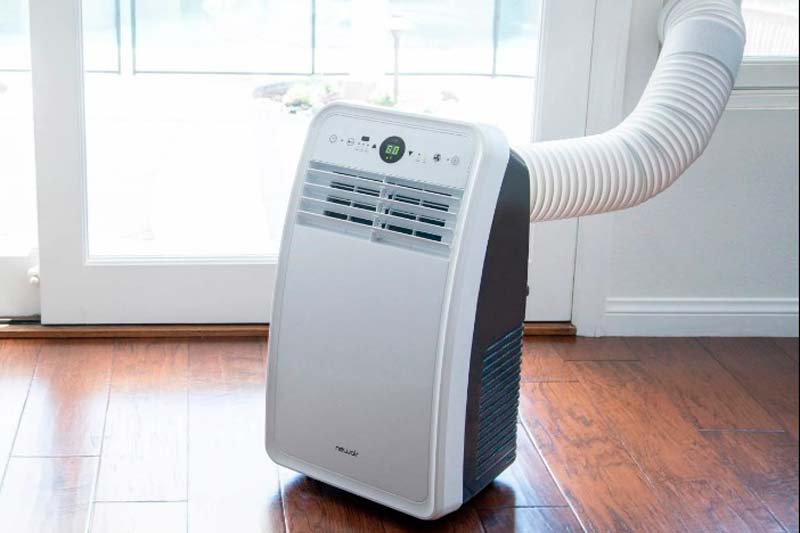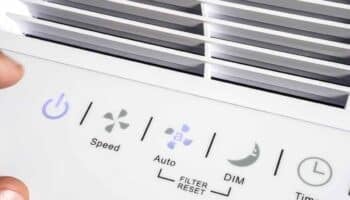You probably know that all ACs create a certain amount of condensation, so it can be alarming to discover that your portable air conditioner is not draining anymore.
Your portable AC may not be draining for a few reasons. You may have a loose hose or connection, your drain hole may be clogged, or it may be filling with condensation too quickly for the draining process. This can happen if you live in or have your AC in an area with particularly high humidity.
Fortunately, none of these problems are hard to fix, so keep reading and I’ll tell you how.
What You’ll Need
Here are a few things you may need.
- Replacement filter
- Bottle brush, or screwdriver, or any long, narrow tool
If Your Portable Air Conditioner Isn’t Draining, Consider the Following
As mentioned above, it isn’t necessarily the end of your cool world if you have a drainage issue. There are a few things to check, so work your way through each of the following. But first.
High or Low Humidity Areas

Do you live in an area where high humidity is the norm during the summer months? Or do you have your AC in a naturally humid room? Perhaps a room with a large fish tank, or your kitchen or bathroom.
If that’s the case, your portable AC may fill too quickly. In typical conditions, you might need to drain your air conditioner every 8 hours or so, but if you have a humidity issue, you’ll need to drain in shorter cycles.
Try cutting that down to 4 hours, which will be a challenge if you leave it running overnight or if you’re away from home all day. Or just experiment with different cycles to find the time frame that’s able to keep up with draining your condensate.
The flip side of this is areas where there is little to no humidity—like Arizona, where much of the state is either arid or semi-arid.
If the air is completely dry, any moisture or condensate your air conditioner creates will be evaporated almost instantly. And you won’t have anything to drain.
Okay, let’s move on to what else you can look into.
Check Your Filter
Dirty air filters are the culprit of all kinds of HVAC issues—including an AC that fills with water so quickly it doesn’t drain properly.
A lack of sufficient airflow can cause condensation to build up.
Here’s what to do—assuming you haven’t changed your filter in the last few weeks.
Note that there are several different types of portable AC filters, so you’ll need to establish what kind you have and if you’re supposed to clean or replace them.
Depending on your make and model, you could have one or more of the following:
- Pre-filters
- Silver ion filters
- Activated carbon
- Antimicrobial
- 3M filters
If you want to get any replacement part – or see how much one would cost – click to enter your model number in the search bar below. Our partners at AppliancePartsPros stock almost every part with free guides on how to install them.

The typical recommendation for filter maintenance—replacing or cleaning—is once every month during the cooling season. If your AC has been beeping at you, this could be an indication that your filter needs changing.
Step 1
Open your AC’s front grill following the manufacturer’s guidelines.
Step 2
Inspect the filter. If it’s dirty change or clean it, depending on the manufacturer’s requirements.
Step 3
If you cleaned the filter, make sure it’s 100% air dry before putting it back in the unit. If it’s still damp or wet when you put it back in, you’re inviting mold and mildew to settle in and take root.
Check the Drain Hole and Line
If your AC drain line gets clogged with dirt, sediment, mold, or whatever, it won’t allow for proper drainage. Fortunately, it’s fairly easy to fix. Just note that your unit may have more than one drain hole, so be sure to check them all.
Not all models will have a water tank. Some will drain without collecting water in a tank first, while others will. This means some units will have a drain line or tube and others will simply have a drain hole. Regardless, if the drain is clogged, water isn’t escaping.
And, of course, if your unit has a reservoir that requires you to manually take it off and empty it, that’s what you’ll need to do.
Step 1
Unplug the air conditioner.
Step 2
Unplug the drain cap or remove the line.
Step 3
Use a bottle brush, screwdriver, or any other long, narrow tool to dislodge anything that might be stuck in the line. Keep flushing water through it until it flows freely.
Step 4
Replace the line and plug your unit back in again.
Check Your Condensate Pump (If Applicable)

Do you use a condensate pump with your AC? These are used when you need to work with—or against—gravity to move the water from your unit.
If your pump has issues and isn’t moving your condensate anymore, your AC will fail to drain.
Step 1
Check the power supply for the pump—and the pump itself—to see if it’s working properly.
Step 2
Check the outlet your pump is plugged into with another small appliance such as a hair drying to make sure power is getting to the pump.
Step 3
Make sure the drain hose is still properly connected to the condensate pump.
Step 4
Test the water sensor in the pump by gently shaking the unit left and right. If the sensor is stuck, release it.
Conclusion
For the most part, sourcing and fixing an issue that would cause a portable air conditioner not to drain is fairly simple and straightforward.
To recap, here are some possible issues.
- High or low-humidity areas
- Dirty filters
- Clogged drain hole or drain line
- If you use a condensate pump, check to make sure it’s working properly
Hopefully, one of these will help you get your air conditioner back up and running optimally.
While you’re here, why not check out some of our related posts below? Perhaps we can help you with something else.







